Convertible
.jpg)
A convertible or cabriolet is an automobile body style that can convert between an open-air mode and an enclosed one, varying in degree and means by model. Convertibles evolved from the earlier phaeton, an open vehicle without glass side windows that sometimes had removable panels of fabric or other material for protection from the elements.
Historically, a retractable roof consisted of an articulated frame covered with a folding textile-based fabric similar to that on an open carriage evolved into the most common form. A lesser seen detachable hardtop provided a more weatherproof and secure alternative. As technology improved a retractable hardtop which removes and stows its own rigid roof in its trunk appeared, increasingly becoming the most popular form.
A semi-convertible also known as a cabrio coach has a retractable or removable top which retains fully framed windows on its doors and side glass. A landaulet is a semi-enclosed convertible with a fully enclosed front cabin and an open rear, typically with a folding fabric top and roll-down glass all round.
Many convertibles are two-door models, with a number of four-door models.
Other terms
In British English: all-weather tourer, a four-door car, and for a two-door car drophead coupé were used for high-quality, fully enclosed versions of the body style known as the "convertible" in the United States.[1] Other common terms include cabriolet, cabrio, soft top, drop top and where the roof is little more than emergency weather protection open two-seater, rag top, spider, and spyder.
There is rarely consistency about the (current) use of cabriolet in preference to convertible,[2] and the former term can not be equated with the cabrio coach term mentioned above that originates from "a light, two-wheeled, one-horse carriage with a folding top, capable of seating two persons."[3]
Folding textile roof
The collapsible textile roof section (of cloth or vinyl) over an articulated folding frame may include linings such as a sound-deadening layer or interior cosmetic headliner (to hide the frame) – or both – and may have electrical or electro-hydraulic mechanisms for raising the roof. The erected top secures to the windshield frame header with manual latches, semi-manual latches, or fully automatic latches. The folded convertible top is called the stack.
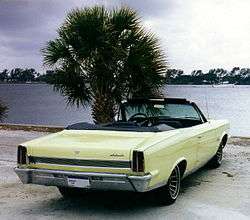
Pros and cons
Pros
Among the advantages of fabric convertible tops are:
- All-round visibility
- Maximized ventilation
- Ease of entry and exit
- Ability to transport large objects
Cons
Disadvantages of fabric top convertibles include:
- Potentially reduced safety.
- Poor break-in protection.
- Deterioration and shrinkage of the sun-exposed textile fabric over time.
- Problems with trunk floor pan rust-through due to leakage of an improperly maintained top.
- A heavier vehicle and higher curb weight due to additional structure required to restore both torsion and flexure stiffness normally provided by a metal roof and (in some cases) door window frames, and additional weight from motorized mechanisms (where provided). Body-on-frame styles usually included an entire X-brace within the conventional ladder frame.
- A narrower rear seat due to space required by the folded side rails.
- Potential diminished rear visibility due to smaller rear window or UV deterioration of plastic pane
- Potential diminished structural rigidity, requiring significant engineering and modification to counteract the effects of removing a car's roof.[4]
- Potential scuttle shake, where an insufficiently rigid bulkhead between engine and passenger compartment can impact ride or handling.
- Potential reduced aerodynamics compared to an equivalent coupe, especially with the top down.
- Potential increased wind noise, moisture intrusion with the top up
- Potential reduced cargo space.[5]
Tonneau cover
.jpg)
Folding textile convertible tops often fail to completely hide their internal mechanism or can expose their vulnerable underside to sun exposure and fading. A tonneau cover provides a solution.
Material
There are a range of available materials for soft tops.
Canvas: Early convertibles used canvas. Automakers had problems in securing raw materials to fulfill orders after World War II, including canvas in various shades for convertible tops and limiting their manufacture.[6]
By 1955, the most popular materials were latex and butyl rubber fabrics that each accounted for approximately 35% of the convertible top poundage with others included vinyl (12%), jute (8%), as well as rayon and acrylic fibers (Orlon), amounting to about 1% each in the compositions.[7]
PVC: Polyvinyl chloride (PVC) material was used for many convertible tops. The material consists of two layers: a top layer made of PVC, which has a specific structure depending on the vehicle model, and a lower layer made of fabric (usually cotton).
Haartz cloth: Almost all automakers currently use one of a variety of fabric construction and designs produced by The Haartz Corporation, a major supplier of soft top fabrics, for their new and more expensive convertibles.[8]
Windows
Side windows non-existent in open cars which may have detachable side screens, are manually or power operated glass side windows as in a saloon or sedan. Rear-windows have evolved similarly, with plastic rear-windows appearing as late as the first generation Porsche Boxster. Contemporary convertibles and retractable hardtops feature heatable glass rear windows to maximize visibility – though rear windows often can compromise visibility by their size, as with the case of the very small rear window and restricted visibility of the Mitsubishi Eclipse Spyder. Plastic windows can degrade, fade, yellow and crack over time, diminishing visibility.
Windblocker
A windblocker or wind deflector minimizes noise and rushing air reaching the occupants. Mazda pioneered a version on the RX7 convertible which featured an integral rigid opaque panel that folded up from behind the front seats. Current convertibles feature windblockers of various designs including detachable fold-up designs (e.g., Toyota Solara), vertically retractable glass (e.g., Audi TT), minimal flaps (e.g., Mazda Miata) – or other integrated wind controlling systems.
According to the engineer responsible for the 2008 Chrysler Sebring, its windblocker reduces wind noise by approximately 11 to 12 dB.[9]
Mercedes and Audi currently offer a heating duct to the neck area of the seat on SLK, SL, and A5/S5 models marketed as an "Air Scarf".
Windblockers are also available on the aftermarket for use on convertibles that do not have them.
Safety
Contemporary convertible design may include such features as electrically heated glass rear window (for improved visibility), seat belt pre-tensioners, boron steel reinforced A-pillars, front and side airbags, safety cage construction – a horseshoe like structure around the passenger compartment – and roll over protection structures or (ROPS) with pyrotechnically charged roll hoops hidden behind the rear seats that deploy under roll-over conditions whether the roof is retracted or not.
The Volvo C70 retractable hardtop includes a door-mounted side impact protection inflatable curtain which inflates upward from the interior belt-line – vs. downward like the typical curtain airbag.[10] The curtain has an extra stiff construction with double rows of slats that are slightly offset from each other. This allows them to remain upright and offer effective head protection even with an open window. The curtain also deflates slowly to provide protection should the car roll over.
Variations
Convertibles have offered numerous iterations that fall between the first mechanically simple but attention-demanding fabric tops to highly complex modern retractable hardtops:
Roadster: A roadster was an open two-seater possibly with a frame that required actual assembly (i.e., not retracting) and separately installable soft side "window" panels – offering little protection from inclement weather and often requiring time-consuming apparently complicated installation. Examples range from the very first cars to the vintage Porsche Speedster introduced in 1955, and the Jaguar XK120 Roadster unveiled in 1948 right up to the most recent Porsche Spyders. For most in the U.S., a contemporary roadster is a two-seater convertible such as the Jaguar F-Type, BMW Z8, Aston Martin V8 Vantage, and Dodge Viper.
Fixed-profile: In contrast to convertibles where the entire bodywork above the beltline (doors, roof, side pillars, side bodywork) is replaced with a folding or retractable roof, the fixed profile convertible retain portions of fixed bodywork including the doors, side pillars and side elements of the roof — while a center fabric portion slides back and accordions at the rear. As an example, Citroën's 1948 Citroën 2CV featured rigid bodysides and two doors on each side, along with a sunroof that rolled back on itself and extended to the rear bumper in place of a separate boot/trunk lid. Other fixed-profile convertibles include the 1950 Nash Rambler Landau Convertible Coupe, the Nissan Figaro (1991) — as well the 1957 Fiat 500 and its 2007 Fiat 500 successor. The 1984 Heuliez-designed Citroen Visa Decapotable used elements of a fixed-profile convertible.
Four-Door: Buick advertised a Series 60 "Convertible Phaeton" body style in the 1934 Model Year, which was actually a four-door convertible, [11] 1938-39 Roadmaster, and 1940-41 Super. Oldsmobile in the 98 Series 1941-47, and Cadillac in 1939 Series 61, and 1940-41 Series 62 models. The Lincoln Continental was available as a 4-door convertible in model years 1961 to 1967.[12] Current production 4-door convertibles include the Jeep Wrangler Unlimited.
Peugeot presented the a concept four-door retractable hardtop convertible, the Peugeot 407 Macarena in 2006.[13] Produced by French coachbuilding specialist Heuliez, the Macarena's top can be folded in 60 seconds,[13] with a steel reinforcing beam behind the front seats incorporating LCD screens for the rear passengers into the crossmember.[13]
Drophead Coupe, Coupé Cabriolet or Coupé Cabrio: A type of convertible with only two doors,[14] and thereby recalling the cabriolet carriage. With its Mazda RX-7 convertible, Mazda introduced a two-seater convertible with a removable rigid section over the passengers, removable independently of power operated textile section behind with heatable glass rear window. During the 1980s, Jaguar produced an XJ-SC with two removable panels over the front seats and a partial fold-down convertible section in the back. It retained the rear side windows of the coupe and had fixed cant rails above these and the door glass. This allowed an almost full convertible with roll-over safety. Going back in Jaguar history, during the 1950s the XK 120 Drophead Coupe (DHC) and later variants, provided open-air motoring with quite civilized fully lined insulated tops with the weather-protection of the hardtop models.
Off-road: Another type of convertibles is the off-road vehicles with removable soft tops such as Jeep Wrangler, Suzuki Escudo, Suzuki Samurai, Ford Bronco, Land Rover Defender, Mercedes-Benz G-Class, early models of Toyota Land Cruiser, Land Rover Defender etc. All these models are available with various types of soft tops that attach to the roll cage or to the installation points on the vehicle's body.
There are soft tops with glass, plastic or flexible vinyl windows. The common off-road soft top types are: full soft top (covers the interior, doors and includes windows), halftops (cover the space above the front seats, doors with windows, backdrop behind the front seats and stretch over the rear seats and cargo area), bikini tops (cover the roof area above the interior and cargo compartment, or just the space above the front seats).
Other: Citroën marketed the C3 Pluriel (2003-2010), configurable into five open top variations, hence the name.[15] Pluriel is a cognate with the English plural. The Pluriel can be configured as a hatchback with a multi-layer insulated top;[16] a full-length landaulet, operable partially or to the back window or any stage in between, with a buffet-minimizing wind deflector over the windshield;[16] a fixed-profile convertible, with the roof open to the back window, the roof assembly folds into a well in the trunk floor;[16] a full convertible where roof side rails are unlatched and removed.[16] and as a roadster pick-up, where the back seats fold to a pickup-like bed with a drop-down tailgate.[16]
History

The earliest automobiles were all open. By the end of the nineteenth century folding textile or leather roofs, as had been used on victoria or landau carriages, were being used on some automobile bodies. The first automobile offered with an enclosed body was the Renault Type B from 1899.
An early car built for comfortable transportation was likely to have an enclosed passenger compartment at the rear for the owner and his guests while the driver sat in front either in the open (in a brougham or a coupé de ville) or under an extension of the roof of the passenger compartment (in a limousine). In some versions the passenger compartment would have a folding roof; these cars were called landaulets.
Less expensive cars were usually open. Whether these were economical runabouts, sporting roadsters or phaetons, or sturdy touring cars, their weather protection was similar, varying from none at all to a rudimentary folding top and detachable side curtains.
In the 1920s, when steel bodies began to be mass-produced, closed cars became available to the average buyer and fully open cars began their disappearance from the mainstream market. Convertibles, being cars that could convert from being open to being fully closed, entered the market in the mid-1920s.
United States automakers manufactured a broad range of models during the 1950s and 1960s – from economical compact-sized models such as the Rambler American[17] and the Studebaker Lark, to the more expensive models such as the Packard Caribbean, Oldsmobile 98, and Imperial by Chrysler.
Proposed major safety standards suggested during the mid-1970s for the 1980 model year included a 50-mile-per-hour (80 km/h) crash to the front, at 25 mph (40 km/h) on the sides, as well as a rollover at 30 miles per hour (48 km/h), a test that open top convertibles would unlikely be able to pass. Although the requirements were reduced, sales of convertible body styles were falling during the early-1970s. Automobile air conditioning systems were also becoming popular. In 1976, Cadillac marketed the Eldorado as "the last of the American Convertibles". During this period of low convertible production, T-tops became an alternative for a few models.
Elsewhere globally, convertible production continued throughout this era with models such as the Mercedes SL, the VW Beetle Cabriolet, and the VW Golf Cabriolet.
In the 1980s convertibles such as the Chrysler LeBaron and Saab 900 revived the body style in the United States – followed by models such as the Mazda Miata, Porsche Boxster, Audi TT, and later retractable hardtop models.
Detachable hardtop

Rigid removable hardtops, many of which store in a car's trunk, have been around at least since the 1950s. These normally provide superior weatherproofing, soundproofing, and durability compared to fabric-based tops, some with integrated rear window defrosters and windscreens. Examples include the first and eleventh generation Ford Thunderbird, second and third generation Mercedes SL, Porsche Boxster, Jeep Wrangler, and Mazda MX-5. Many of the rigidity concerns of a standard convertible are present, even with the roof attached, although in the case of the early Daimler SP250s, the hardtop does give some extra rigidity. However, weatherproofing, climate control, and cabin security are improved.
Retractable hardtop

A retractable hardtop, also known as coupé convertible or coupé cabriolet, employs an automatically operated, multi-part, self-storing hardtop.
American Ben P. Ellerbeck created a manually operated retractable hardtop prototype in 1922 — for a Hudson coupe that never went into production.[18] The first French version was the Georges Paulin designed 1934 Peugeot 601 Éclipse[19][20]
By 2006, advances in electronics, hydraulics, and weatherproofing materials had made the modern retractable hardtop increasingly popular. Pros and cons include ease, enclosed car quality climate control with the top up, improved crash resistance, and passenger compartment storage security on the plus side and increased mechanical complexity and expense and, more often than not, reduced luggage capacity on the minus.
A 2006 New York Times article suggested the retractable hardtop may herald the demise of the textile-roofed convertible,[21] and a 2007 Wall Street Journal article suggested "more and more convertibles are eschewing soft cloth tops in favor of sophisticated folding metal roofs, making them practical in all climates, year-round."[22]
Construction
Retractable hardtops can vary in material (steel, plastic or aluminum), can vary from two to five in the number of rigid sections and often rely on complex dual-hinged trunk (British: boot) lids that enable the trunk lid to both receive the retracting top from the front and also receive parcels or luggage from the rear – along with complex trunk divider mechanisms to prevent loading of luggage that would conflict with the operation of the hardtop.
Galleries
Open car and roadster
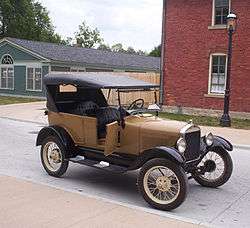 Ford Model T c. 1925, with minimal weather protection
Ford Model T c. 1925, with minimal weather protection Bentley 4½ Litre 1929 with luxury snap-on and thumbscrew sidescreens
Bentley 4½ Litre 1929 with luxury snap-on and thumbscrew sidescreens Ford Phaeton 1934 open 4-door touring car
Ford Phaeton 1934 open 4-door touring car
 Lancia D23 Spyder 1953
Lancia D23 Spyder 1953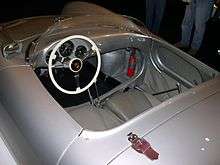 1955 Porsche 550 Spyder
1955 Porsche 550 Spyder
Convertibles
 fixed-profile Nash Rambler Convertible "Landau" Coupe c. 1950
fixed-profile Nash Rambler Convertible "Landau" Coupe c. 1950 Jaguar XK c. 2008, with heatable glass rear window and fully automatic cloth top with integral top-concealing rigid tonneau
Jaguar XK c. 2008, with heatable glass rear window and fully automatic cloth top with integral top-concealing rigid tonneau Mercedes SL c. 1963, perhaps the most popular detachable hardtop
Mercedes SL c. 1963, perhaps the most popular detachable hardtop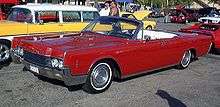 Lincoln Continental c. 1966, 4-door with integral automatically operating, self-storing tonneau
Lincoln Continental c. 1966, 4-door with integral automatically operating, self-storing tonneau Jaguar E-type c. 1970, with vinyl foldable tonneau installed and snap-secured
Jaguar E-type c. 1970, with vinyl foldable tonneau installed and snap-secured Cadillac Eldorado 1972, with detachable, two-part, fully rigid "parade boot" tonneau cover
Cadillac Eldorado 1972, with detachable, two-part, fully rigid "parade boot" tonneau cover Citroen 2CV c. 1975, with roll-back roof and rigid doors
Citroen 2CV c. 1975, with roll-back roof and rigid doors Rolls Royce Corniche c. 1986, a high-end prestige marque with a manually installed tonneau cover
Rolls Royce Corniche c. 1986, a high-end prestige marque with a manually installed tonneau cover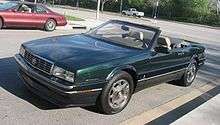 Cadillac Allanté c. 1993, with detachable, rigid plastic tonneau cover. Built in Italy by Pininfarina, completed bodies were flown to the U.S. 56 at a time in specially equipped Boeing 747 with final assembly at Hamtramck, Michigan.[23]
Cadillac Allanté c. 1993, with detachable, rigid plastic tonneau cover. Built in Italy by Pininfarina, completed bodies were flown to the U.S. 56 at a time in specially equipped Boeing 747 with final assembly at Hamtramck, Michigan.[23] Volkswagen New Beetle c. 2003, with raised textile (cloth) convertible top featuring interior headliner, an acoustic insulation layer, and heatable glass rear window
Volkswagen New Beetle c. 2003, with raised textile (cloth) convertible top featuring interior headliner, an acoustic insulation layer, and heatable glass rear window Porsche Boxster c. 2004, with detachable clear plastic windblocker and a Z-fold top, automatically raisable in 12 seconds[24] and optional 51 lb (23 kg) detachable aluminum hardtop (not shown)
Porsche Boxster c. 2004, with detachable clear plastic windblocker and a Z-fold top, automatically raisable in 12 seconds[24] and optional 51 lb (23 kg) detachable aluminum hardtop (not shown) Citroën C3 Pluriel c. 2007, a multi-configurable convertible with roll-back textile roof and removable rigid sidebars[15]
Citroën C3 Pluriel c. 2007, a multi-configurable convertible with roll-back textile roof and removable rigid sidebars[15]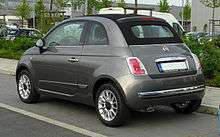 A Fiat 500 (2007) fixed-profile convertible
A Fiat 500 (2007) fixed-profile convertible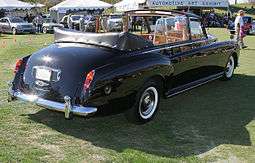 1966 Rolls-Royce Phantom V landaulet
1966 Rolls-Royce Phantom V landaulet Mercedes-Benz 300d landaulet in operation
Mercedes-Benz 300d landaulet in operation
Retractable hardtop
.jpg)
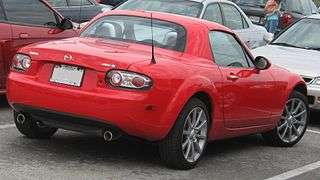 Mazda Miata Power Retractable Hard Top (PRHT) c. 2007, with 77 lb (35 kg) polycarbonate hardtop and identical cargo capacity to the soft top version[25]
Mazda Miata Power Retractable Hard Top (PRHT) c. 2007, with 77 lb (35 kg) polycarbonate hardtop and identical cargo capacity to the soft top version[25] Cadillac XLR c. 2007, with fully retracted aluminum (i.e., lightweight) hardtop concealed by self-storing tonneau cover, the hardtop manufactured by a supplier joint venture of Mercedes-Benz and Porsche[26]
Cadillac XLR c. 2007, with fully retracted aluminum (i.e., lightweight) hardtop concealed by self-storing tonneau cover, the hardtop manufactured by a supplier joint venture of Mercedes-Benz and Porsche[26] Daihatsu Copen c. 2001 with retracted hardtop, qualifying for the ultra-compact Japanese Kei class
Daihatsu Copen c. 2001 with retracted hardtop, qualifying for the ultra-compact Japanese Kei class- Ford Focus CC c. 2006 with its roof retracted, its final assembly performed by Pininfarina

- Volkswagen Eos c. 2007, the five-segment top features an independently sliding sunroof, made by OASys
See also
Non-automotive
- "Rag Top Down", a 2012 rock song
- "Red Rag Top", a 2002 country song
References
Notes
- ↑ Beattie 1977, pp. 36, 42–43.
- ↑ "Convertible and Cabriolet what's the difference?". Convertible Car Magazine. February 29, 2012. Retrieved July 11, 2015.
- ↑ "Cabriolet". Dictionary.com. Random House. Retrieved July 11, 2015.
- ↑ Garrett, Jerry (8 October 2006). "2007 Volkswagen Eos: In Praise of a Convertible Goddess". The New York Times. Retrieved 6 March 2011.To neutralize the loss of torsional rigidity inherent in any convertible, VW engineers took the basket-handle roll bar of the VW Cabrio, inverted it and placed it under the rear seat pedestal. A beefed-up windshield frame of hot-stamped ultra-high-strength steel is connected directly to the floorpan’s reinforced frame rails. Steel tubing provides more stiffness behind the doors for an extra layer of safety. Partly as a consequence, rear seat passengers have about 10 inches less shoulder room than in the smaller Rabbit.
- ↑ "What You Should Know Before Buying a Convertible". Edmunds. Retrieved 6 March 2011.
- ↑ "The Last Roadster". Cars and Parts. 43: 42. 2000. Retrieved 11 January 2016.
- ↑ Jacobs, Milton (1957). Fabrics and Fibers for Passenger Cars: Automobile Manufacturers' Views, 1955 Compared with 1950, Issue 152 of Marketing research report. U.S. Department of Agriculture, Agricultural Marketing Service, Marketing Research Division. pp. 8, 40–41. Retrieved 11 January 2016.
- ↑ Stroll, Daniel (2009). "Muscle Car Interior Restoration Guide". CarTech. p. 120. ISBN 9781932494983. Retrieved 11 January 2016.
- ↑ Chrysler Group (30 March 2007). "2008 Chrysler Sebring Convertible's Solid Structure and Systems Deliver Smooth Driving, Tight Handling and a Quiet Ride" (Press release). prnewswire.com. Retrieved 6 March 2011.
- ↑ "Volvo C70 - safety, the next generation". Autoblog.com.
- ↑ File:1934 Buick Series 60 Convertible Phaeton.JPG
- ↑ Cars of the Sizzling '60s, by the auto editors of Consumer Guide (Publications International, Ltd., Lincolnwood, IL, 1997), pages 68 to 69, and 307.
- 1 2 3 "¡Hey, Macarena! Heuliez Creates an Open-Top Peugeot 407". Edmunds. 2006-01-28. Archived from the original on 19 December 2006.
- ↑ "Cabriolet definition". Reverso Online Dictionary. Retrieved 6 March 2011.
- 1 2 "Citroen C3 Pluriel (2003–) Review". Archived from the original on 5 November 2007.
- 1 2 3 4 5 "Citroen C3 Pluriel". honestjohn.co. 28 May 2003. Retrieved 3 February 2014.
- ↑ "All new (AMC advertisement)". Life. 50 (22). 2 June 1962. Retrieved 4 April 2014.
- ↑ Nerad, Jack. "Ford Skyliner". DrivingToday.com. Retrieved 3 February 2014.
- ↑ "Disappearing Top On Auto Worked By Push Button". Popular Mechanics. 63 (2): 253. February 1935. Retrieved 14 August 2013.
- ↑ "Latest Foreign Auto Has Disappearing Top". Popular Mechanics. 65 (1): 53. January 1936. Retrieved 14 August 2013.
- ↑ Sass, Rob (10 December 2006). "New Again: The Hideaway Hardtop". The New York Times. Retrieved 6 March 2011.
- ↑ Vella, Matt (26 April 2007). "Convertibles with Hard Tops". The Wall Street Journal. Retrieved 3 February 2014.
- ↑ Schuon, Marshall (19 April 1987). "The few, the rich, Pininfarina". The New York Times. Retrieved 6 March 2011.
- ↑ "2007 Porsche Boxster news, pictures, and information". Conceptcarz.com. Retrieved 6 March 2011.
- ↑ Vaughn, Mark (10 September 2006). "2007 Mazda MX-5 Miata Power Retractable Hardtop". Autoweek. Retrieved 6 March 2011.
- ↑ Keebler, Jack (August 2002). "2004 Cadillac XLR". Motor Trend. Retrieved 6 March 2011.
Bibliography
- Adler, Dennis (2011). Convertibles. First Gear series. Minneapolis, MN: Motorbooks. ISBN 9780760340202.
- Beattie, Ian (1977). The Complete Book of Automobile Body Design. Haynes Publishing Group. ISBN 0-85429-217-9.
- Beattie, Ian (1987). Automobile Body Design. Haynes Manuals. ISBN 978-0-85429-217-2.
- Benson, Michael (1997). Convertibles: Sun, Wind & Speed. London: Tiger Books International. ISBN 1855019507.
- Georgano, Nick (2001). Beaulieu Encyclopedia of the Automobile. Routledge. ISBN 978-1-57958-367-5.
- Hirsch, Jay; Weith, Warren (1979). The Last American Convertibles. New York: Collier Books; London: Collier Macmillan. ISBN 002080010X.
- Holmes, Mark (2007). Ultimate Convertibles: Roofless Beauty. London: Kandour. ISBN 978-1-905741-62-5.
- Langworth, Richard M (1988). The Great American Convertible. New York: Beekman House. ISBN 0517655810.
- Wieder, Robert; Hall, George (1977). The Great American Convertible: An Affectionate Guide. Garden City, NY: Doubleday. ISBN 0385131232.
External links
| Wikimedia Commons has media related to convertibles. |